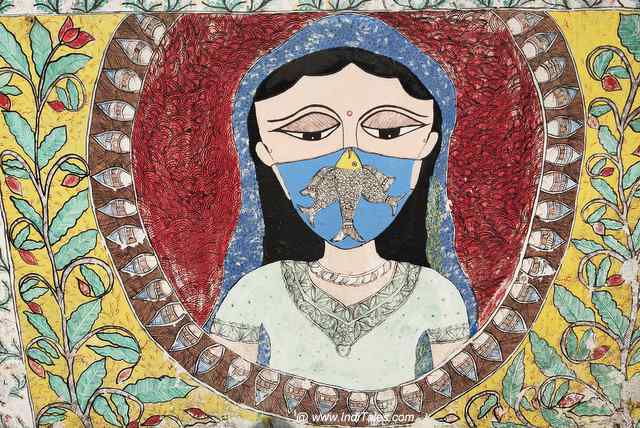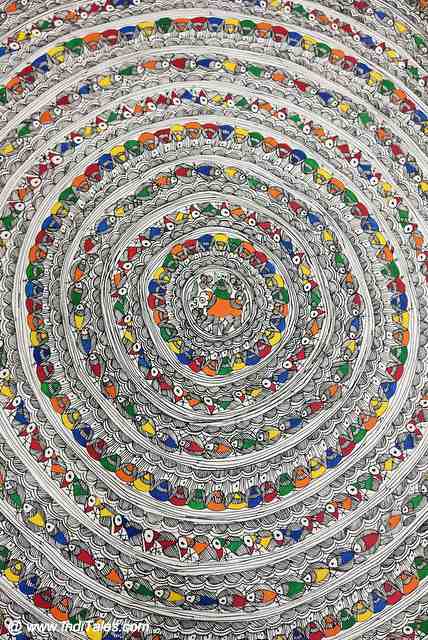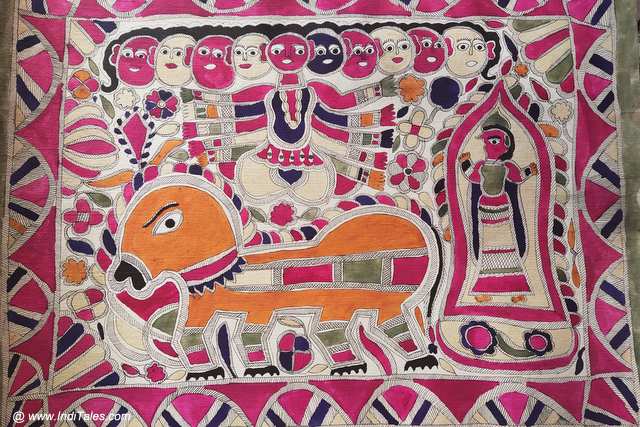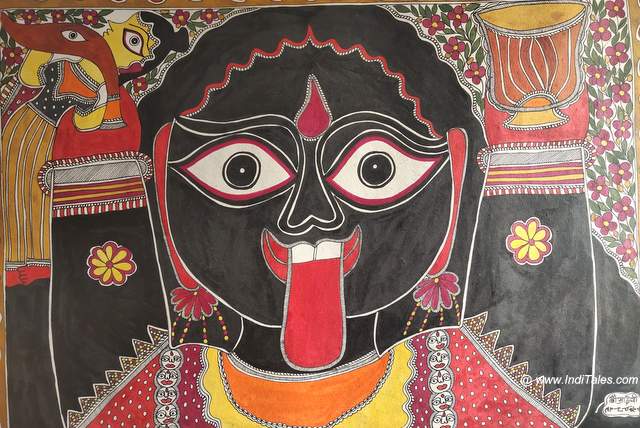Madhubani paintings are the most prominent art from the Mithila region of Bihar. Madhubani is a town in Mithila that played its role in taking this local art form global so Madhubani Paintings is the name that the world knows.
Brief History of Mithila
The Mithila region of Bihar lies mostly between the north banks of the Ganga and the foothills of the Himalayas in Nepal.
It is best known for being home to Mata Sita, who was also known as Maithili as she hailed from his region. Her father’s kingdom was in a place called Janakpur which is now in Nepal but just a few kilometers across the border.
Sita was born or rather found in a place called Sitamarhi. However, she first met and then married Sri Ram at Janakpur. Ram-Janaki wedding is a popular theme in Mithila Paintings.
Mithila region is known for innumerable ponds that are found here, fish that is fondly eaten here, Makhana or foxy nuts that grow here in abundance, sweet language, and smiling people. It is primarily an agrarian society.
Legacy of Mithila or Madhubani Paintings
Mithila paintings were traditionally wall art, that the women painted on their walls. They were also ritual paintings that would be painted during weddings, childbirth, or different festivals.

Paintings were not meant to be permanent. They painted again every time there was a new event in the family demanding a new painting.
Like every folk art, there is a lot of stylistic and content coding within the paintings. Every community has its own motifs and icons that they painted.
The distinction has gone away with the severe commercialization of the art form. Today, individual artists do have their signature styles but most of the themes are dictated by market demand.
Modern Avatar of Madhubani Paintings
Madhubani Art was first noticed outside the region when British Surveyors visited the region after an earthquake in the 1930s. However, it would need another earthquake in the 1960s for these paintings to become the face of Mithila.

In the 1960s earthquake Pupul Jayakar assigned photographer Bhaskar Kulkarni to survey the Madhubani area. They thought taking the wall art to paper would create a source of livelihood during these tough times for this agrarian community.
This was when artists started painting on paper instead of walls, something that they could sell easily. Exhibitions were organized to take this art to the world. Lalit Narayan Mishra who was a foreign minister then, and who hails from this region, applied his push to take it to international platforms. Organizations like Ethnic Arts Foundation stepped in to help.

Slowly and firmly, Madhubani paintings made their presence in the global art world. You could see them on walls around the globe. Since most outsiders interacted with Madhubani, it came to be known as Madhubani paintings. Traditionally it was a ritual art form practiced across Mithilanchal.
They may have never realized this would become their signature art form for the rest of the world.
Different Types of Madhubani Paintings
Madhubani paintings can be divided into two bases.
The first is based on the Jati or the communities. Each community would use its own heritage and socio-culture to paint on its walls. What joins all of them is that be it Brahmins, Kshatriyas, Kayasthas, or Paswans, all of them practice this art form.
Second, is based on the painting styles. This has three main components
Kachhni – The line drawing that is made in free hand by the artist.
Bharani – It literally means filling. So, this is the filling of colors in the line drawings.

It is the combination of Kachhani and Bharani that creates a Madhubani Painting. Most scenes are depicted using these two techniques.
Godana – Godana is the traditional art of tattoo that was practiced across communities in India. There are traditional motifs that were engraved on the skin. Since they were primarily made on the exposed parts of the body like hands and neck, these motifs are usually small in size.

When these small motifs, were transferred on paper, a lot of them were drawn to create a painting. These paintings tend to be more geometrical and have a fuller effect on paper.
Tantrik Paintings – These are paintings drawn by those who follow the Tantra path of worship, mostly Shakta worshippers. They typically paint deities like Dash Mahavidyas along with the Yantras. Sometimes they draw just the yantras.
These paintings are used for Sadhana and worship.
Kohbar – Ritual Painting for Weddings
This is a ritual wedding painting created in the room of the bride and groom by all the communities in Mithila. It carries various fertility and prosperity symbols. It is usually drawn on the eastern wall of the room.

The key elements include:
- A lotus flower in the center with its expanding petals
- Flora and Fauna
- Shiva and Parvati
- Wedding Rituals like Puja by the couple
- Sun, Moon, and other planets as a witness or to bless
The nuances may differ in different communities and different families. Overall, the objective of this painting is to seek protection and blessings for the newlywed couple.
Earlier Kohbar used to draw fresh on the wall. Now, most people get it made on paper and paste it on the wall. Even at the homes of legendary artists, we saw the paper ones in practice.
Individual Styles
Every painter or artist also has their own choice of motifs and colors. While the styles of prominent artists like Ganga Devi have been studied and documented, each one of them has a distinctive signature.
Colors Used in Madhubani Paintings
If I ask you to close your eyes and think about the most used colors in these paintings, you may see black lines prominently with small blobs of different colors. You may see the dominance of black and red color on a beige or off-white background.

The dull beige background is created by applying a layer of cow dung on paper and allowing it to dry in sun.
Like most Indian painting traditions, the colors in Mithila also came from natural sources like plants, flowers, and home products like soot. Only some artists continue to use colors like Gerua or rust color. Most have shifted to easy-to-use, readily available, and long-lasting acrylic colors.
India is a country that loves colors, that too vibrant colors. So, the traditional paintings used to be in bright Holi colors like – Magenta, Bright Yellow, Sparkling Green, etc.
Black and White Madhubani Paintings
However, when the commercialization happened, it was the customer demand that dictated the colors. After the 1960s, we see a prominence of black and white and other subtler colors. It was probably driven by the demand in the West.

Curators, who were the mediators between the artist and the rest of the world, also dictated the color schemes. In fact, at times they told different communities to use certain colors and motifs so that they could clearly define different styles.
Folk art as we know evolves organically and has no clear boxes or boundaries to limit it. However, the art market needs clear boxes to be able to create a demand. This is how paintings in Mithila paintings evolved in the last few decades.
Visiting Madhubani Paintings Villages in Mithila
On our trip to Mithila, we were looking forward to visiting the villages that have produced no less than seven women artists decorated with the Padma Shree award.
My imagination was walking into the villages with paintings all around. I hardly saw any paintings in Darbhanga, where we were based except on the Government buildings where both traditional and modern scenes were painted. We could not find any such villages.

We thought of visiting Madhubani town, where I knew that the railway station has been painted very meticulously. I had visuals of Ratnagiri railway station in Maharashtra that has Warli paintings on its walls.
Finally, a stroke of luck has us meet the historian Dr. Narendra Narayana Singh ‘Nirala’ ji, who is an expert on Madhubani Paintings. He spoke to us in detail about the modern avatar of Mithila Paintings and how organizations like Ethnic Arts Foundations played the role.
Nirala ji told us about many institutes that have been established to formally teach the art form. He said – Mithila paintings are found everywhere in Mithila but what is sold to the outside world are Madhubani Paintings.
Nirala ji took us to different villages to meet different artists and also different styles painted by them. After this, he also shared his personal collection of old paintings with us.
Jitwarpur Village
Jitwarpur village is best known for Madhubani Paintings.
We first visited Krishna Kant Jha ji at his home. He is a Mahapatra Brahmin and works primarily on scenes from epics like Ramayana and Mahabharata. Currently working on paintings of Hanuman, he very kindly allowed us to watch him paint.
He first drew on the border with multiple straight lines. Then he created a border between the lines using triangles. After watching him, I noticed that indeed every Mithila painting has a similar border.
Then he drew the outline of Hanuman ji holding a mountain in his hand. His hands moved with ease as he drew lines with his free hand, without using anything but a pen dipped in black ink.
Once complete, he or someone else in his family will fill the colors and the painting is complete. Yes, most paintings are a teamwork of family members. The master artists draw the outline and others help by filling in the colors.
If you pass by his home, you may never imagine that it is the home of a successful commercial artist. He not only sells his paintings from home but also visits different places to teach the art form to students. He also gets invited to paint walls in public or private places.
Shanu Paswan’s House
We then went inside the village to see the Paswan community paintings. Here we did find some houses painted. At the home of Shanu Paswan ji, we saw a lot of Godna-style paintings. We met Sheela Devi ji whose out-house was full of paintings with a part still work in progress.

Here we saw the local rituals of the community being painted like Rahu Puja and the stories of the folk deity Raja Salhesh or Sailesh. Paintings feature animals like tigers prominently.
It reminded me of the Cherial Paintings of Telangana.
Tantrik Paintings of Krishnanand Jha
To visit this artist’s home, we had to literally walk through the fields to reach the house at the end. The wife of the Late Krishnanand Jha ji greeted us and showed us the album with photographs of all the paintings done by her husband.

She then opened a bundle of paintings that included Dash Mahavidya, Dashavatar of Vishnu prominently among other paintings. Since these paintings are used for worshipping, they are mostly made on order.
Padmashri Godavari Dutt
In the end, we visited the home of Padma Shri Godavari Dutt in Ranti Village. She has one of the best Kohbar drawn on the wall of her living room. In her 90s, Godavari ji was not very mobile, but she still welcomed us with open arms, with motherly affection.
Her daughter-in-law Anjani Devi ji showed us the paintings around the house and explained the Kohbar to us. She represents the Kayastha community and her paintings have dominant black, red, and white colors.
Godavari Dutt’s work is exhibited at the Mithila Museum in Tokamachi in Japan. She has visited Japan multiple times to create the museum collection there.
Madhubani Sarees Studio in Darbhanga
In Darbhanga, we visited the studio of national award-winning Madhubani artist Asha Jha ji. Besides paintings, she specializes in painting Madhubani Saris and Dupattas.
Her daughters gifted me a Paag and a Dupatta which is traditionally offered to guests. It is worn by Maithili Brahmins during formal occasions. You can not move your head much when you wear it.
Her designs are in demand as much as her customized Saris are in demand. Check out the Madhubani Paints’ website or IG Handle.
Travel Tips for Madhubani

Madhubani is well connected by Rail and Road. Darbhanga is the closest big city and airport.
Jitwarpur is best known as the village of Madhubani artists.
It is not easy to go there on your own. I do not think there are any organized tours that take you to these villages. So, get in touch with a local who can take you to these artists.
If you are not keen on meeting the artists, but only want to buy Madhubani paintings, Dilli Haat in Delhi is a better bet. Most of these artists participate there on a regular basis.
A lot of them sell online, so look out for them on Amazon.
To learn, you can contact Upendra Maharathi Shilp Anusandhan Sansthan in Patna who conducts free courses to teach Madhubani Paintings.
You can stay in Darbhanga where there are few options to stay.
